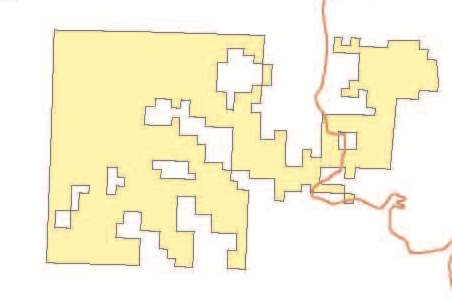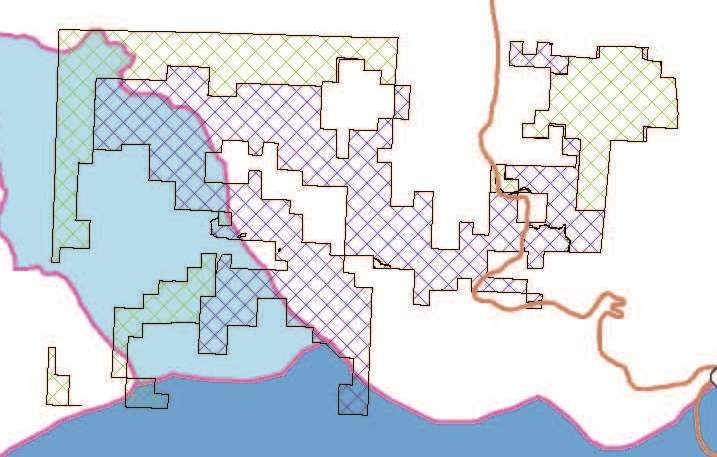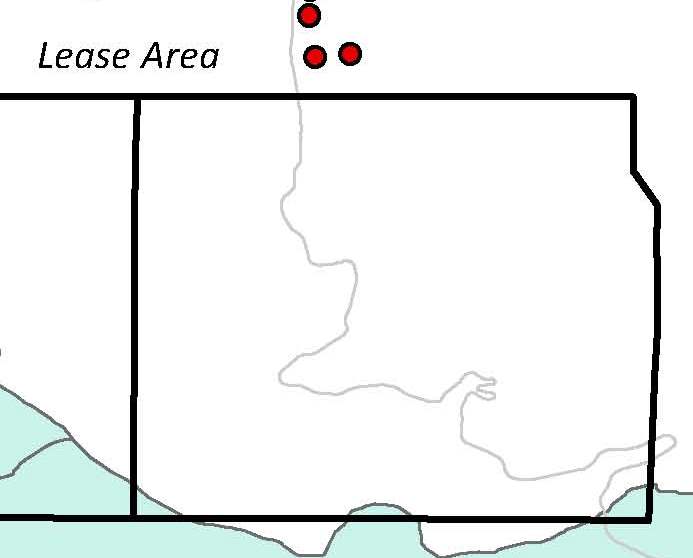| University of Colorado at Boulder | ||||||
 |
||||||
Results of The Watershed Plan for the Town of
Palisade
|
| Figure 1 | Figure 2 | Figure 3 |
|---|---|---|
 |
 |
 |
Upon the nomination of the parcels in 2005, before they were put up for auction in 2006, the BLM approached the Palisade town manager and Grand Junction city manager to discuss the nominations and potential lease stipulations (both managers had left their positions by the time of the lease sale). At this time, the BLM also asked for these two communities' input on any additional concerns they had. The BLM received letters from both communities outlining their concerns and notifying the BLM that they would file protests against the sale of the leases. Catherine Robertson, the BLM Grand Junction Field Manager, explained that this informal “heads-up” about the protests was appreciated, and it gave the BLM a chance to internally discuss how to resolve the concerns of the communities.
BMP subjects identified as necessaryby WWG:
Hydrological Studies
Collaborative Plans of Development (PODs)
Clustered Development and Well Pad Spacing
Collaborative Storm Water Management Plan
Subcontractor Education<
Emergency Response Plan:
Hazardous Materials Management, Spill Prevention,
Control, and Countermeasures, Health and Safety
Air Quality
Closed Loop Drilling Systems
Well Construction – Cementing/Casing Programs
Well Control- Maintenance of wellbore integrity
Pressure Monitoring- Bradenhead
Green Fracturing
Fracture Tracing
Produced Water Disposal
Collaborative Visual Studies
Subcontractor Hiring Policy and Conduct
Fire Abatement
Staging Areas
Pipelines
Interim and Final Reclamation Procedures
For a complete listing of BMPs in the Watershed Plan, go to the BMP Bibliography Search page; search for “Palisade” in the keyword panel; click on the Watershed Plan; click on “View all BMPs from this publication”.Palisade and Grand Junction filed formal lease protests in January of 2006, regarding the BLM's February 2006 oil and gas lease sale. BLM regulations require that when a protest is filed on a lease, any outstanding issues must be resolved before the issuance of the lease is finalized. At this point in the process, the BLM decided that a one-year moratorium on drilling would be applied to the purchaser of the leases, in order for the concerns of the communities to be addressed. Robertson emphasized that Genesis was fully aware of this stipulation prior to purchasing the leases, and were accepting of the opportunity it would give them in working with the communities. Genesis also made commitments that went beyond federally and locally mandated development requirements, including a voluntary no-surface occupancy on 960 acres considered very vulnerable to contamination. Genesis agreed to collaborate with the communities through the Watershed Working Group (WWG), composed of various watershed stakeholders, including city officials and community members from Palisade, Grand Junction, the greater Mesa County area, the Ute Water Conservancy District, the Mesa Water and Sanitation District, the BLM, the United States Forest Service, and Genesis. Although the Colorado Oil and Gas Conservation Commission (COGCC) is one of the regulatory agencies involved in drilling activities, it was not considered a stakeholder in the watershed plan. Neither were local environmental groups (e.g., the Western Colorado Congress) or individual community members participants in the negotiations. During the one-year moratorium on development of the leases within the watershed, the stakeholders created what would become the Watershed Plan for Palisade and Grand Junction.
After several public forums, the WWG created and released the Watershed Plan in August of 2007. This agreement is a voluntary, non-binding plan that outlines the goals to, “address and resolve issues and concerns within the watersheds”, and to “protect air, land and water resources within the Palisade and Grand Junction watersheds”, while maintaining a good working relationship among all stakeholders. This plan addressed the environmental concerns of the communities and outlined the best management practices (BMPs) that would be used throughout drilling and development to protect the health of the watersheds. The Watershed Plan established the following definition of BMPs that would be used during the development of natural gas resources in the watersheds:
An on-the-ground action to mitigate a known potential impact or a process to be followed to achieve a specific outcome. The implementation of BMPs within the watersheds, will mitigate, minimize, and/or prevent adverse impacts. The list of BMPs is not all-inclusive, as differing situations on the ground will dictate the actual protection measures.
The Watershed Plan includes the background and development of the plan, a description of the need for the plan, the steps for implementation of the plan, the issues and concerns established by the public, and descriptions of BMPs that would be used to address these concerns and ensure enforcement throughout the development process. The plan also includes a section that addresses the legal requirements that regulatory agencies such as the BLM, U.S. Forest Service and COGCC, would be responsible for enforcing. The section addresses the regulatory requirements, procedures, and oversight that Genesis is legally bound to follow, with the assistance and enforcement responsibilities of these agencies. All local ordinances and the National Environmental Policy Act (NEPA) regulations can be found in the appendices within the plan.After the Plan
Genesis has not developed or drilled within the watershed as of March 2011. Greg Trainor, the Grand Junction Utility and Street Systems Director, notes that the cost of drilling in the watershed area would likely be very expensive because of the necessary precautions that must be taken to properly implement the BMPs laid out in the plan. Trainor also explained that drilling done by other companies near, but not within the watershed, has not lead to any major gas extraction. Robertson believes that no drilling occurred because of the downturn in the economy and increased cost of natural gas over the last few years. She also noted that Genesis committed to developing leases outside of the watershed first, to show that they were determined to be good corporate citizens in their development. Genesis still owns the leases within the watershed, but if they were to sell the leases to any other energy companies, those developers would be expected to follow the standards laid out in the plan despite the non-binding nature of the document.
Community Feedback and Satisfaction
“These communities take great pride in their watersheds and this is reflected in the concerns that were raised and steps that were pursued to protect the health of the watersheds.”Interviews with Trainor, Tim Sarmo, the Palisade Town Administrator, and Matt Sura, former director of the Western Colorado Congress (WCC), provided insights on their own participation in developing the plan, activities in the area since the plan was created, and satisfaction of the communities with the plan. According to Trainor, the municipalities were determined to use all of their ability to protect the watershed, if the BLM was not willing to act and adopt stipulations such as the one-year moratorium. Citizens of Grand Junction showed their determination by spearheading adoption of a watershed ordinances, which was subsequently included in the plan. Palisade had had a watershed ordinance since 1997. Sura explained that Grand Junction, a Colorado home rule city, proposed a watershed ordinance two years before the nomination of the leases, but it was voted down. Upon the nomination of the leases, a second citizen initiative push for an ordinance, by groups such as the WCC, resulted in the creation of the watershed and water supply protection ordinance. The ordinance was written in a month, and more than 4500 signatures were collected in support of it. Furthermore, Grand Junction incorporated the watershed plan by reference, as well as adding seven additional standards, in their Water and Water Supply Standards (Grand Junction Municipal Code 13.32.270(q)) because the city expects any future oil and gas development activities in the watershed to follow the guidelines laid out in the original voluntary watershed plan.
While environmental groups and community members did not participate as stakeholders in the WWG, they provided comments and support. Sura emphasized the community's concern and participation in protecting the watershed by describing some of the ways that the WCC was able to raise awareness about the issue. In one instance, a local catholic priest dedicated a sermon to the importance of each individual in his congregation taking initiative to protect the watershed. After the sermon, people were lined up to sign ordinance petitions.
Both Trainor and Sarmo believe that Genesis fully cooperated with the community to address their concerns. Genesis fully participated in all meetings, and Trainor and Sarmo noted that a high level of respect and acknowledgment of all concerns existed throughout the creation of the plan. Genesis' cooperation was evidenced by the fact that they never opposed the plan at any step of the process.
Success of the Watershed Plan
At this point it is difficult to determine the success of the Watershed Plan because no development has occurred within the watershed. However, according to both Trainor and Sarmo, the creation of the plan generated much attention. Trainor believes it has the potential to become the BLM's new standards for management practices in the area and that recent COGCC rule revisions stemmed in part from the plan. Robertson thought that the plan allowed for a greater community outreach and education on the processes that were already in place to protect the environment during oil and gas development. She explained that it was an opportunity for the communities to engage with the development company, and not just the BLM. Robertson also said that the creation of the plan allowed for a better understanding of the issues involved, and fostered relationships instead of litigious action, to reach a goal.
Does the community seem satisfied with the final outcome of the watershed plan even though no drilling has occurred to date? Trainor thinks “yes”. He explained that the community places much value on this area and have invested a lot to protect it, so minimal drilling would be considered a positive thing. For the Palisade community, Sarmo agreed that the process was a good opportunity for community input. Although some community members expressed concern that the plan was not legally binding and that it did not go far enough to protect the watershed, he said that it left almost everyone with a better feeling that they could protect the watershed and work with Genesis to ensure that development was done properly. In a 2007 interview with the Denver Post, Jim Doody, the Mayor at the time, stated that the creation of the plan was the “second-best option the BLM could give us, the best option would have been: 'You can't drill in the watershed.'”
The Future of Development in the Watershed
Sarmo noted that the Watershed Plan was a preliminary document, and was speculative of any development that may occur, because Genesis had no detailed information on the production capacity of the area covered by the leases. Even though the stakeholders considered this plan as a generic look at potential development, it showed that questions could be answered, communication between stakeholders could be productive, and issues regarding what could happen in cases of development could be addressed. Sarmo also noted that if these leases were developed, the communities would expect further agreements and plans to be made with Genesis or any subsequent developers.
BLM Oil and Gas Development Process:
Land Use Planning
Leasing
State and Local Permitting
APD Processing
Clearances
InspectionsTo develop its federal leases, an energy company is required to submit an Application for Permit to Drill (APD). Upon the submission of an APD, the BLM requires an environmental assessment of potential impacts. The BLM can approve an individual well with a site specific environmental review or review tiered to the area’s Resource Management Plan or field development Environmental Impact Statement. The BLM prepares Resource Management Plans (RMPs) to guide the management of any public lands that are considered for prospective resource development. The Grand Junction BLM Field Office issued an RMP in January1987, and expects to have a revised RMP available for public review in the spring of 2012.
Regardless of these required planning and environmental analysis processes, however, Sarmo explained that Palisade would like to see other more detailed plans like a state comprehensive drilling plan (CDP), or BLM master development plan (MDP) prepared for development in the watershed, even though neither is necessarily required. Robertson noted that this was clear to the BLM and that Genesis has already acknowledged that it is expected, and they have agreed to the creation of a MDP for watershed development. It was also noted that anything proposed in the MDP would be modified in conjunction with community input.
Although Genesis has not moved forward with development, the Watershed Plan still serves as a model for future natural gas development. This agreement showed that communities and stakeholders can collaborate to strive towards the best outcome for every involved party, while protecting the environment, and contributing to local community growth through natural resource development.